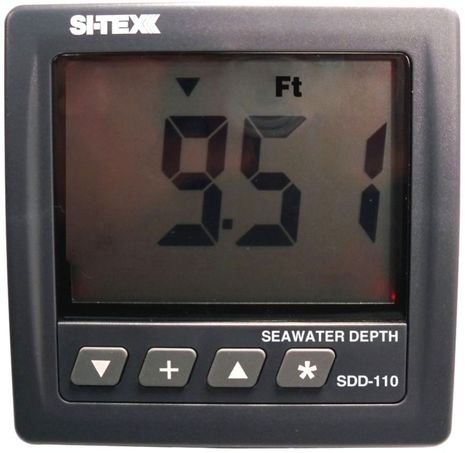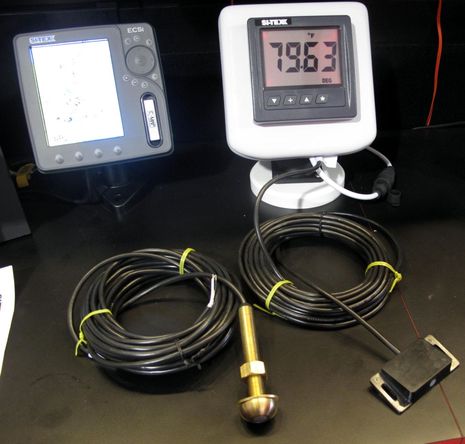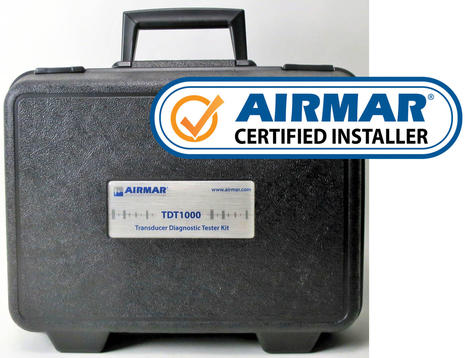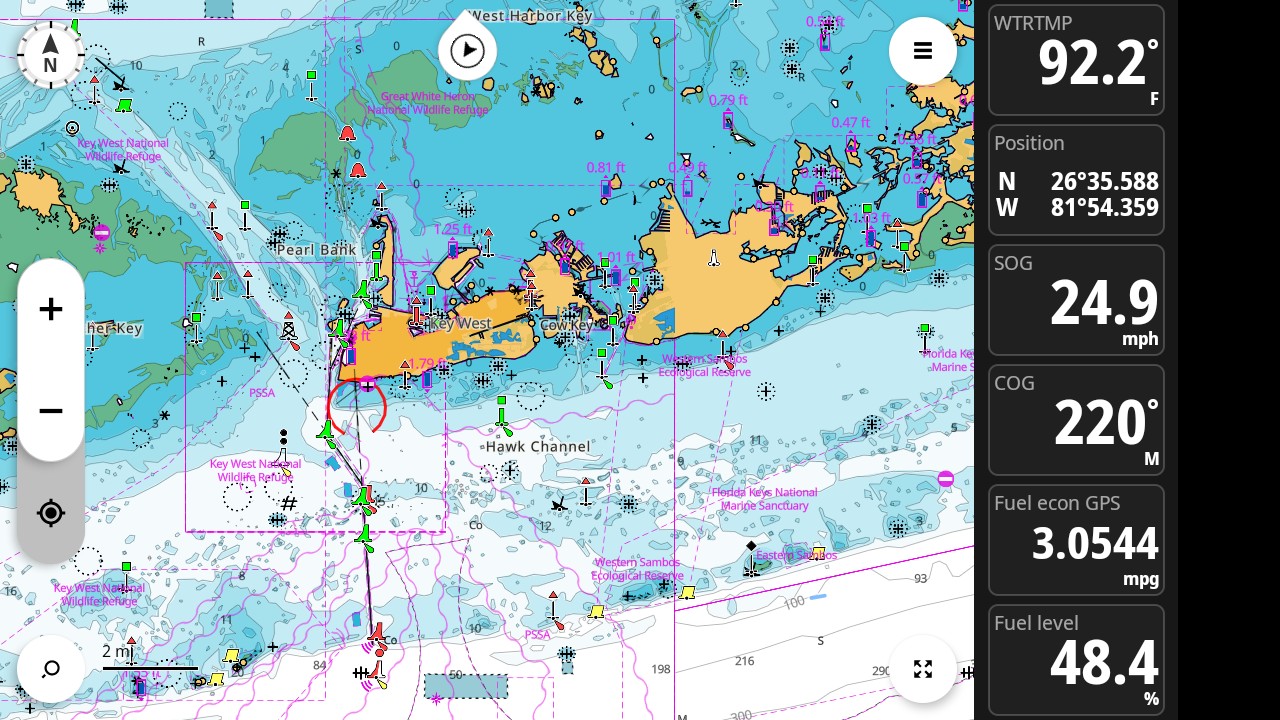Standalone, economical instruments; Si-Tex finds it niches?
I sometimes wonder how the smaller marine electronics manufacturers will get along as more and more boaters seem to go with systems centered on do-it-all MFDs from the Big Four brands. So it’s good to read on the Si-Tex home page that the company turned a profit in its first year under new management. The trick seems to be filling niches that the big boys have largely abandoned, like the new standalone SDD-110 Digital Depth Gauge above, which will drop right into the hole left by a venerable Datamarine Offshore Sounder and only retails for $349, excluding an ‘inexpensive’ transducer…
The SDD-110 is not on the Si-Tex site yet, but you can find plenty of details by checking out the D110 from the New Zealand manufacturer CruzPro, where it was clearly sourced. Actually you could buy the D100 for about $90 less, according to the info here, but I doubt you’ll get the sales and customer service Si-Tex brings to the equation. Plus, though the CruzPro version seems to have about every feature you’d want in a standalone sounder, Si-Tex may have had them make a modification or two. That’s another stradegy Si-Tex employs, as I learned with the SP-36 autopilot, which is sourced from ComNav.
I don’t know if Si-Tex actually manufactures anything these days, but that doesn’t matter if most boaters have never heard of the source companies. Especially if said boater is looking for standalone electronics. For instance, there aren’t many choices left when it comes to a plain, but able-seeming radar like the T900 discussed here in 2009, or its fishfinder brethren. Si-Tex also seems to have hit a niche with the precision SST-110 Sea Surface Temp Guage it introduced in Ft. Lauderdale last Fall (seen below). It, too, seems sourced from CruzPro, but I didn’t see U.S. fishermen enthuse about it until Si-Tex got involved.
















That is a funny picture, two decimal accuracy on depth? And I can just hear someone asking “what if I want to use it in freshwater, not seawater???”.
Good to know I’ve got an option when my Datamarine craps out though!
What I don’t understand is why a simple instrument like costs $349? I did a quick google searth on fishfinders, and found a Garmin 140 for $94 and MANY others for less than $150. It had a graphic display and a LOT more processing power than this depthsounder, but is less than 1/3 the price
What gives here?
The stand alone instruments are in fact NASA with re-designed fascias. SiTex have a long history of using NASA as a Manufacturer, and are their Primary US Distributor. They do the AIS and Navtex re-badged.
Whilst not wanting to burst SiTex’s bubble, peeps should be aware that they are avaialble direct from http://www.nasamarine.com or other UK dealers like http://www.allgadgets.co.uk at much less cost. Allgadgets specialises in export to non-EU countries.
Steve
Geez, Steve, did you even look at the CruzPro links? Si-Tex works with many sources and I’m nearly certain that these instruments are made by CruzPro, no fascia redesign needed. Please compare Si-Tex, CruzPro, and NASA yourself and see what you think.
I haven’t seen or tried NASA’s instruments, but if they are anything like the AIS receiver I once tried, CruzPro’s engineering is a much superior:
https://panbo.com/archives/2005/10/nasasitex_ais_receiver_first_impressions.html
https://panbo.com/archives/2008/03/nasa_ais_engine_2_as_screwy_as_1.html
https://panbo.com/archives/2007/04/cruzpro_max110_geek_gauge.html
While cruising cruzpro’s site I discovered a very nice piece of Techie Candy in the MaxRp110 User Configurable NMEA 0183 data Repeater with settable high and low alarms. It allows us to build our own screen and data summary on a PC to show on the instrument under way. At $300 its just at the threshold of pain for electronic boat toys!
Of course, IF I got one it would be, ahem, serious safety equipment.
I did Ben, and the Display looks exactly similar to the NASA, I dont know what the relationship is between Cruz Nasa and SiTex, but I’m fairly confident there is one, especially given the SiTex relationship with NASA. Whether these are NZ copies of NASA or made under licence, I would be fairly confident of finding an Alan Mulley designed board under there, or a modified copy of it.
Whatever it is, the same product(s) can be had here much cheaper, whatever brand name it’s under.
There are just too many similarities for it to be coincidental.
Steve
I should also say really that the early NASA AIS was a bit of a disaster, but they were the leisure pioneers in the field. If you compare every NASA product, to that, then you will be missing out. Over the years I have had over a dozen bits of NASA gear on my boats, and nothing has ever let me down, unlike some other brands I could mention. They are cheap yes, but always do what they say on the can, in a workmanlike no-frills way. They are aimed fairly and squarely at the DIY yottie/mobo who knows a bit about NMEA and computers. Their Target HF3 SSB RX is brilliant and even outperforms my Yeasu FT847 on RX sensitivity.
Steve
Steve, NASA doesn’t even seem to have a standalone temp gauge, let alone a new high precision one like both Si-Tex and CruzPro do. And there’s much more evidence…
Would you care to place a wager on whether NASA or CruzPro manufacture the Si-Tex instruments? Hopefully a really large one?
OK Ben accepted, I’m willing to lay $50, or a night propping up the bar, that either NASA or Alan Mulley as an individual is somehow involved in this, whether by design, copying, or licensing, whatever. If I’m wrong I’m wrong and I’ll take it on the chin, but there’s too many design similarities for me to turn that one down. I can only do $50 because I’m a hard up radio engineer struggling to start a new business.
I take it you are back from Paris now?? Why on earth didnt you drop by the UK as well, we were on the South coast all last week no more than 200 or so miles away from you. You would have been most welcome and we could have met up with Steve Bryant as well on the IoW.
Steve
Ha! I just got this note from Si-Tex VP Allen Schneider confirming that CruzPro manufactures their depth and temp gauges. He also notes that the gauges are customized for Si-Tex and discusses the company strategy:
“Thank you for the chance to comment on this issue. As one of your readers also stated we source out our products from MANY different suppliers. While It is very true that NASA Marine supplies our AIS Black Box Receivers, the AIS Radar, and NavFax 200 receiver along with optional accessories, they are only one of our many suppliers!
When it comes to Cruz Pro they are simply building a product to meet our requirements! We are not just changing the front panel as some of your readers may think. There are many modifications to the Software and Hardware done to meet our requirements without having to start from scratch building a new product. This saves time and money when bringing a new product to market. To date there are 10 different companies that build products for us to our specific requirements, we are not just window shopping products. I have found that there are many hundreds of small marine electronics manufacturers’ around the world that build high quality products that are never marketed in the USA.
When we identify a product that we need to fit a specific niche we contact our supplier that has the best capability to produce a product for us to fill that niche. We then start the process of molding the product to meet our needs and the preferences of the American marketplace. This may seem simple but I can assure you it is not simple. Once we are satisfied that the product will meet our needs, we Sea-trial it and make sure that it is going to perform properly, and work reliably for our customers. At this point in the process the number one issue is reliability! We are backing all of our products up with a 2 year warranty and if the product is not reliable it could cause us to incur a financial loss down the road, which is bad news for a small company. The major advantage that SI-TEX brings to the plate for the average boater is that we are finding these products, vetting them out, and standing behind them with some of the best customer service in the industry. The boating customer is dealing with a very knowledgeable and responsible American company that backs these products up with a 2 year Warranty as well. And that is something that you totally do not get if you purchase the product overseas and bring it to the USA yourself, in which case it is totally buyer beware!
I think that many of your readers would be surprised to found out how common a practice this is in the Marine Electronics industry. I am not going to mention any specific brands, but, many of the largest Companies in the Marine Electronics business do not own the production lines that produce products for them, all manufacturing is contracted out to outside vendors much like we do! Most of these companies are very simply Marketing & Distribution Companies not manufacturers in the true sense!”
Stick your chin up, Steve, and gather your assets for that bar night (probably some time very far in the future). I just got this reply from Bert van den Berg, founder of CruzPro (and, I think, one of those Yankees who sailed to NZ and never left):
“You are 100% correct in that we supply Si-Tex both the SST-110 (our WTP-110) and the SDD-110 (our D110). These products have been in our stable for many years and are 100 percent original with us. These are not copies of anyone’s products. As Alan has already said on your blog, we modified the software and hardware for Si-Tex at their request.
Further to rxc’s comment as to why a standalone depth sounder can cost more than a cheap fishfinder – it’s because of performance and the fact that we don’t build them by the zillions in Asia (lower volume market).”
OK Ben, Never say I dont make good on my promises, a cheque will be with you shortly. Have a good night on me. I have failed to contact Tony at NASA to confirm, (they still must be on holiday). After many hundreds of hours poring over NASA instruments, that LED display just seems a tad too familiar.
Maybe it comes from the same source.
Anyway, you win…as always.And good on yer.
Intersting what the chap at SiTEX said, of course that practice has been going on since the 80’s or earlier, particularly in Radio manufacture. Uniden FI were hardly ever known outside the industry, but they poured out radios for hundreds of other brands,on all frequencies and only became known when starting their own brand. Rexon was another similar but now defunct company. I think Marine radios at one time came out just three plants two in China and the other (if it’s still there), in Korea. The exception to this is Standard Horizon/Yaesu/Vertex and Icom who both have their own factories.
Steve
Good gosh, Steve, I wasn’t serious about the money. Please don’t send a check!
>>>SDD-110 Digital Depth Gauge above, which will drop right into the hole left by a venerable Datamarine Offshore Sounder and only retails for $349, excluding an ‘inexpensive’ transducer…>>>
I can’t let this go without comment. I realize that a lot of this yacht stuff is pitched toward boaters with seemingly bottomless pockets and wallets…
However, in my frugal niche, I will be buying the
Humminbird HDR610 digital depth gauge, usually available for $79, including transducer. See:
http://store.humminbird.com/products/409813/HDR_610_P
Ben, I think you’re being very insensitive re: price-points…some of us are actually being hampered by present economic conditions, and are forced to stretch dollars. I can buy four of the Humminbird 610s for the price of one SDD-110…why should I not?
Karl,
Many of us wouldn’t consider the Hummingbird, it is back in the dark ages when boat electronics didn’t talk to each other (e.g. no NMEA connectivity).
There are displays 4x the cost of the Si-Tex (Not sure what you would have written if Ben wrote about those). Comparively this Si-Tex display Ben wrote about would scrape by in the minimum feature department for many of us (not NMEA-2000, but with 0183 it can connect), standard size, good visability, and for people on a 12 volt energy budget this display can be extremely attractive.
I would not buy it if I were you, I have one and it sucks. Very inconsistent if it works at all.
Posedion, you mean the Humminbird HDR 610, right? Have you tried trouble shooting or calling customer support?
Incidentally, one difference between the Si-Tex/CruzPro depth gauge and the Humminbird is that the former runs at 120kHz and the latter at 200. That means the Si-Tex/CruzPro pings deeper and won’t interfere with a typical 50/200kHz fishfinder that might also be on some of the boats that would use this product. There are numerous other differences.